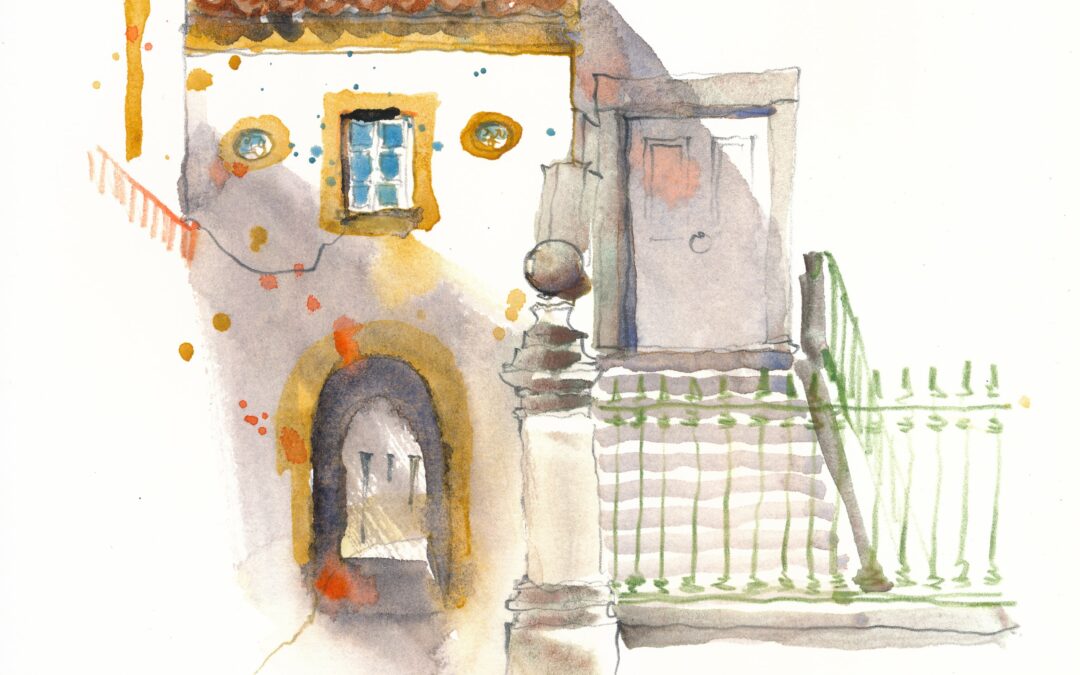I’m off again to my next trip in Portugal to work on my book. In the meantime I just published my new Skillshare class featuring video’s of my previous trips in portugal. I also show you how I prepare my sketchbook and what I take with me on my trips.
I’ve been keeping travel sketchbooks for over 10 years and they’ve become and essential part of the way I keep my souvenirs, for pleasure and to make my books.
They’re also the best way to remember your travel afterwards: when you draw a place, you are really mindful and present, more than when you take a picture. When you look to your drawings afterwards you’ll remember and relive all the sounds, smells and thoughts of that day. Memories will immediately come back to you!
In this class I’m showing you the real behind the scenes action as I fill my travel sketchbooks in 3 Portugal trips with watercolour sketches that will eventually end up in my new book I’m making about that country with Editions Akinome. I filmed in real time during my travels, with very little material, sketching outside, so some video’s are less comfortable than usual, but this way I can share with you some of my struggles and challenges as I fill those pages.
Sketching outside is a challenge. Almost every artist I know often feels frustration and uncertainty with the act of sketching outside and showing his work, and making a book. I worry about whether people will like what I make, I worry about whether you will like the video’s and learn something, and I worry about the outcome of the book.
PS: you don’t need to go abroad. Sketching your neighbourhood is fun as well. I do it often! It’s also “Travel Sketching” somehow.
Keeping a travel sketchbook can be a rewarding way to document your journeys and capture memories in a unique and personal way. Here are five pieces of advice to help you make the most of your travel sketchbook:
- Choose the Right Materials
Invest in quality supplies that are portable and suited to your style:
- Sketchbook: Select a durable, travel-sized sketchbook with thick, high-quality paper that can handle various media.
- Pens and Pencils: Bring a range of pencils you like to draw with, or waterproof pens, and some colored pencils if you like to draw with that…
- Watercolors: If you like painting, choose a light, small, portable watercolor set
- Other Tools: Consider carrying an eraser & sharpener if you work with pencil.
- Practice Quick Sketching
Travel often involves limited time and unexpected situations, so develop the skill of quick sketching:
- Capture Essentials: Focus on capturing the essence and major shapes of the scene quickly.
- Prioritize Details, focus on what story you want to tell: Learn to prioritize which details to include and which to omit to convey the scene effectively.
- Document Daily Experiences
Make it a habit to document your experiences and impressions daily:
- Sketch Regularly: Try to sketch something every day, even if it’s just a small coffee or tea cup or a quick scene.
- Write Notes: Add brief notes, captions, or anecdotes to complement your drawings and provide context.
- Vary Subjects: Sketch a variety of subjects, such as landscapes, architecture, people, and objects that catch your eye. Only sketch what YOU like.
- Embrace Imperfection
Your travel sketchbook is a personal record, and it doesn’t have to be perfect:
- Stay Relaxed: Don’t stress about making every sketch perfect; focus on enjoying the process.
- Learn from Mistakes: Use mistakes as learning opportunities. Imperfections can add character and authenticity to your sketches.
- Experiment Freely: Feel free to experiment with different styles, techniques, and media without worrying about the outcome.
- Be Observant and Present
Travel sketching makes you travel more mindfully
- Slow Down: Take the time to really observe the details of your environment.
- Use All Senses: Pay attention to sounds, smells, and the overall atmosphere.
- Interact Locally: Talk to locals, learn about the culture, and capture those experiences in your sketches to add depth and authenticity.
Enjoy and Play !


Bonjour,
Je me réjouis de voir ce nouveau sujet.
Cette année, je suis allée au RHoK Woluwe en tant qu’élève libre pendant le second semestre; j’ai également rédigé un ebook sur mes travaux portant sur 10 oeuvres de Le Corbusier que j’ai visitée, photographiées et peintes (peinture à l’huile Artisan) personnellement.
J’aime beaucoup l’idée d’écrire un texte et d’y joindre des dessins, peintures, croquis. Je pars bientôt en Corse où je vais certainement dessiner la plage et les endroits oū J’irai me promener.
Dernière nouvelle, je me suis inscrite pour 2 jours à la Fondation Folon, comme l’an dernier; à bientôt, donc ,
Et encore merci pour tous tes précieux conseils,
Marie-Paule Polomé
Ah chouette Marie-Paule !
A bientôt !